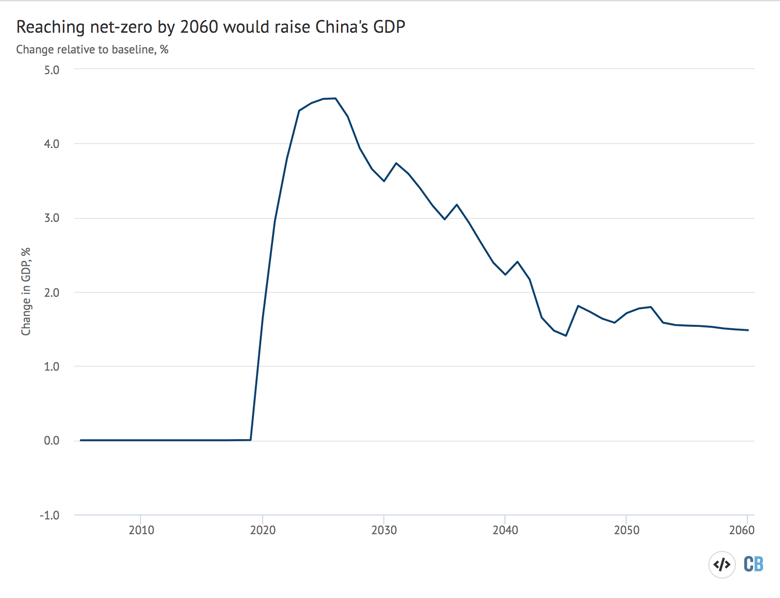
Analysis: Going carbon neutral by 2060 ‘will make China richer’

Hector Pollitt
09.24.20
Hector Pollitt
24.09.2020 | 12:40pmChina’s surprise pledge to reach “carbon neutrality” before 2060 could cut global warming this century by 0.25C and raise the country’s GDP, our new analysis shows.
The significant new announcement, made by president Xi Jinping at this week’s UN General Assembly, means that more than one sixth of the world’s population – and around a third of its CO2 output – has, overnight, been committed to net-zero emissions within 40 years.
We used Cambridge Econometrics’ E3ME macroeconomic model to analyse the implications of the pledge, finding that China’s CO2 emissions would need to fall rapidly to reach net-zero by 2060.

The huge scale of investments required to do this would raise China’s GDP by as much as 5% later this decade, with a modest ongoing positive impact due to reduced fossil-fuel imports.
China’s investments would not only drive dramatic reductions in its own CO2 emissions, but would also lower the cost of clean energy, creating a positive “spillover” effect in other countries.
In total, the pledge could mean global warming this century reaching around 2.35C, some 0.25C lower than the level expected in our baseline – even if others do not raise their own climate goals.
Path to zero
In order to push China to reach net-zero CO2 emissions by 2060 in our model, a whole range of policies would need to be implemented. The foundations are provided by a combination of energy efficiency rules and carbon pricing, built on the country’s nascent emissions trading scheme.
China would also need to offer support for specific technologies to accelerate existing trends in their uptake – for example, via feed-in tariffs for renewables or subsidies for electric vehicles. It would also need to ensure that no new coal plants are built, emphasising the important role of regulation in directing markets towards net-zero emissions.
These interventions would dramatically cut China’s CO2 emissions over the next 40 years, relative to what we would expect under existing policies and technology trends. Cumulatively, this would avoid the release of 215bn tonnes of CO2 over the next four decades, as shown in the chart below.

It is worth noting that, in our modelling, the current policy baseline (blue line in the chart above) already suggests a rapid peak in China’s CO2 emissions before 2025, followed by a decline and longer-term plateau. Other research has already suggested the country could peak well before its previously pledged goal of “around” 2030.
In our baseline modelling, the early peak in CO2 emissions is due to low-cost solar and wind starting to displace coal-fired generation in the electricity grid. This gives an insight into one of the potential motivations for China’s new carbon neutrality pledge.
Global impact
The reduction in China’s CO2 emissions that we modelled – a cumulative 215GtCO2 – is hugely significant relative to the remaining carbon budget for limiting warming to 1.5 or 2C.
But this is not the only way that the pledge could cut emissions, because actions in China can also cause “spillover” effects in the rest of the world. We have seen this already with solar panels, where high levels of demand in China have driven down prices all around the world.
This means that, even if the rest of the world did not implement any new climate policy in response to China’s raised ambition, emissions would still fall in other countries. Our modelling suggests this impact is far from trivial, reaching a saving of more than 500m tonnes of CO2 (MtCO2) per year.
All told, our results show the CO2 cuts due to the 2060 pledge could avoid 0.25C of warming this century. This would mean temperatures rising to 2.35C above pre-industrial levels by 2100, instead of the 2.59C in our baseline scenario.
Our results are similar to the new findings published by Climate Action Tracker, which say the pledge could avoid 0.2-0.3C of warming.
The spillover effects that we found are not all positive. China’s rapid decarbonisation would reduce oil demand, meaning that global prices would fall by up to 5% and the transition to electric vehicles outside China would slow, relative to the baseline and assuming no additional policy interventions.
Larger economy
Decarbonising the world’s current largest emitter will not be cheap. The carbon price in our modelled pathway to carbon neutrality reaches $250/tCO2, in today’s prices.
Relative to the baseline, investment in the power sector alone increases by $4tn (today’s prices, non-discounted) over the 40 years – and millions of people currently work in the coal sector.
However, much of the technology and equipment necessary for decarbonisation is made in China and the country has the capacity to produce more. The country would also substantially reduce its fossil-fuel import bill, at the same time as boosting its efforts to increase self-sufficiency.
As a result, China’s GDP increases in the net-zero scenario relative to the baseline, as shown in the chart below, with significant positive impacts particularly in the short term.

The difference would be particularly large early on, reflecting all the investment required in renewables, but there would also be a smaller long-run benefit, thanks to lower fossil-fuel import costs. China’s energy security would also be improved.
On the flip side, GDP in the rest of the world would fall slightly (<1%), driven by lower export revenues for oil and gas-producing countries – assuming no further policy response outside China. In aggregate, global GDP would go up, with the increase in China outweighing losses elsewhere.
It is important to note that these results do not include any feedbacks from the climate. By 2060, the physical impacts of climate change may be substantial.
Localised pain
The model results suggest that, in aggregate, China will benefit from its new targets. However, there will be localised pain – for example, those millions of coal workers who may struggle to find other jobs and the parts of China that rely on coal extraction would be hit hard.
President Xi’s announcement suggests that he thinks this transition can be managed, with the benefits outweighing the costs. This position contrasts with that of the US, though the upcoming election could change that.
What is clear for now is that China has laid down a marker at a time when many other countries are considering their climate commitments.
Acknowledgements: This modelling work was supported by the NERC FRANTIC project, grant number NE/S017119/1.
-
Analysis: Going carbon neutral by 2060 ‘will make China richer’
-
Analysis: China’s ‘carbon neutrality’ pledge could cut warming by 0.25C

